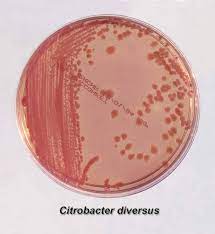Citrobacter koseri: Difference between revisions
No edit summary |
No edit summary |
||
| Line 32: | Line 32: | ||
==Ecology and Pathogenesis== | ==Ecology and Pathogenesis== | ||
<i>Citrobacter koseri<i> inhabitants the intestinal tracts of animals and humans. It does not benefit or work together with another organism. <i>C. koseri<i> is known to be linked with hospital-acquired infections. It does not positively contribute to environment but rather | <i>Citrobacter koseri<i> inhabitants the intestinal tracts of animals and humans. It does not benefit or work together with another organism. <i>C. koseri<i> is known to be linked with hospital-acquired infections. It does not positively contribute to environment but rather causes contamination of an area where it inhabits. <br> | ||
<i>Citrobacter koseri<i> | <i>Citrobacter koseri<i> causes urinary tract infections. Animals and humans are the targets for host. The virulence factors are connected with flagellar apparatus biosynthesis and iron uptake. Symptoms of the microbe include sepsis, meningitis, and cerebritis, seizures, apnea, becoming sickly, and a bulging fontanelle. | ||
<br><br> | <br><br> | ||
Revision as of 20:27, 6 December 2022
Classification
Bacteria; Proteobacteria; Gammaproteobacteria; Enterobacterales; Enterobacteriaceae
Species
|
NCBI: [1] |
Citrobacter koseri
Description and Significance
Citrobacter koseri (formerly Citrobacter diversus)is a member of the Enterobacteriaceae. It has the appearance of straight rods and occurs singly in pairs. The length of the bacillus is 1 micrometer in diameter by 2.0-6.0 micrometers in length. Citrobacter koseri is found in soil, water, and in the intestinal tracts of both humans and animals. It has a negative importance in regards to the cause of neonatal meningitis and brain abscess formation.
Genome Structure
The genome size varies between 4.0 to 5.0 Mb. The GC content of the genomes is between 51 to 56%. It is unknown in the amount of chromosomes it has. C. koseri is circular. The genome consist of 4,536 protein-coding sequences.
Cell Structure, Metabolism and Life Cycle
Citrobacter koseri gains energy solely through using citrate as a carbon source. The molecule it was shown to produce when isolated was hemolysin, which is a substance found in the blood that kills red blood cells and free hemoglobin.
Ecology and Pathogenesis
Citrobacter koseri inhabitants the intestinal tracts of animals and humans. It does not benefit or work together with another organism. C. koseri is known to be linked with hospital-acquired infections. It does not positively contribute to environment but rather causes contamination of an area where it inhabits.
Citrobacter koseri causes urinary tract infections. Animals and humans are the targets for host. The virulence factors are connected with flagellar apparatus biosynthesis and iron uptake. Symptoms of the microbe include sepsis, meningitis, and cerebritis, seizures, apnea, becoming sickly, and a bulging fontanelle.
References
Author
Page authored by Kassidy Cartret, student of Prof. Bradley Tolar at UNC Wilmington.

